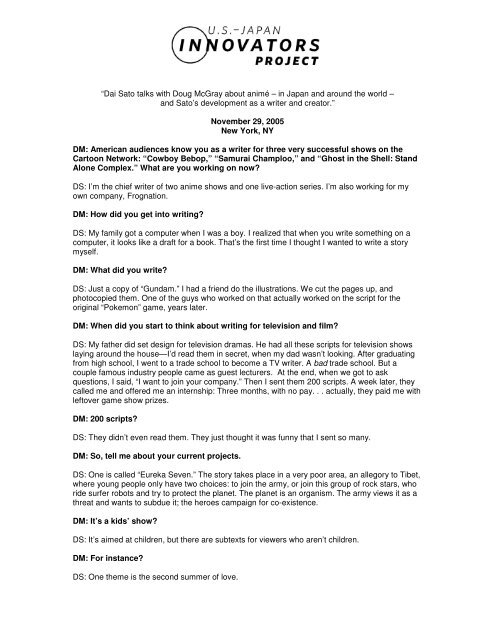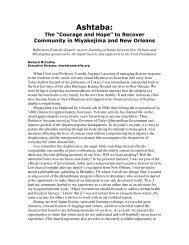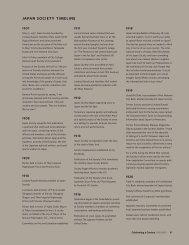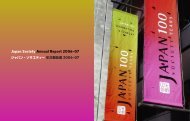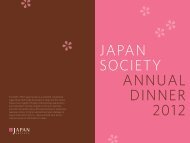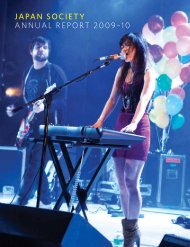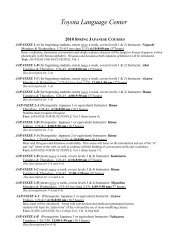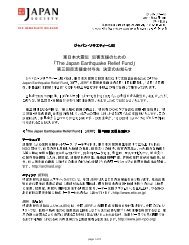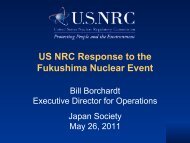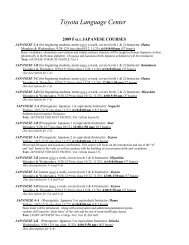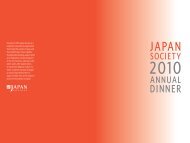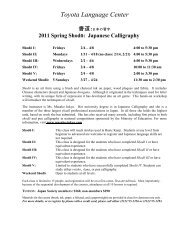Doug McGray's interview with anime screenwriter ... - Japan Society
Doug McGray's interview with anime screenwriter ... - Japan Society
Doug McGray's interview with anime screenwriter ... - Japan Society
Create successful ePaper yourself
Turn your PDF publications into a flip-book with our unique Google optimized e-Paper software.
“Dai Sato talks <strong>with</strong> <strong>Doug</strong> McGray about animé – in <strong>Japan</strong> and around the world –and Sato’s development as a writer and creator.”November 29, 2005New York, NYDM: American audiences know you as a writer for three very successful shows on theCartoon Network: “Cowboy Bebop,” “Samurai Champloo,” and “Ghost in the Shell: StandAlone Complex.” What are you working on now?DS: I’m the chief writer of two <strong>anime</strong> shows and one live-action series. I’m also working for myown company, Frognation.DM: How did you get into writing?DS: My family got a computer when I was a boy. I realized that when you write something on acomputer, it looks like a draft for a book. That’s the first time I thought I wanted to write a storymyself.DM: What did you write?DS: Just a copy of “Gundam.” I had a friend do the illustrations. We cut the pages up, andphotocopied them. One of the guys who worked on that actually worked on the script for theoriginal “Pokemon” game, years later.DM: When did you start to think about writing for television and film?DS: My father did set design for television dramas. He had all these scripts for television showslaying around the house—I’d read them in secret, when my dad wasn’t looking. After graduatingfrom high school, I went to a trade school to become a TV writer. A bad trade school. But acouple famous industry people came as guest lecturers. At the end, when we got to askquestions, I said, “I want to join your company.” Then I sent them 200 scripts. A week later, theycalled me and offered me an internship: Three months, <strong>with</strong> no pay. . . actually, they paid me <strong>with</strong>leftover game show prizes.DM: 200 scripts?DS: They didn’t even read them. They just thought it was funny that I sent so many.DM: So, tell me about your current projects.DS: One is called “Eureka Seven.” The story takes place in a very poor area, an allegory to Tibet,where young people only have two choices: to join the army, or join this group of rock stars, whoride surfer robots and try to protect the planet. The planet is an organism. The army views it as athreat and wants to subdue it; the heroes campaign for co-existence.DM: It’s a kids’ show?DS: It’s aimed at children, but there are subtexts for viewers who aren’t children.DM: For instance?DS: One theme is the second summer of love.
DM: That’s the rise of rave culture in the 1980s.DS: The name of the first episode was “Blue Monday,” which is a New Order song. The robotsare called LFOs, and the enemies are called KLF.DM: Like the 80s club bands.DS: There are a lot of references to my generation’s music and culture. One of the maincharacters is named after a character in “Trainspotting.” Another is named Thurston, afterThurston Moore, of Sonic Youth. The father’s name is Adrock, like Adrock from the Beastie Boys.The grandfather is named Axl, after Axl Rose of Guns N’ Roses. The different generations in theshow are represented by different music cultures. The youngest generation is represented byreferences to dance music, techno, and house. Hip hop represents the next generation, and rockrepresents the oldest generation.DM: Who are all these references for? Hip parents?DS: The show comes on at 7:00 am on Sunday morning. So it’s for kids. But people who hungout at the clubs all night are also going to be tuning in. And the kids who are watching it nowmight figure out the references when they look back in 5 or 10 years.DM: How did the show’s environmental theme emerge?DS: Surfers in real life are close to nature. I <strong>interview</strong>ed many of them when I was developing“Eureka Seven.” They taught me this idea of wanting to protect the environment because it’s funto surf. And it resonated <strong>with</strong> me much more than a moral argument. I thought it might be aneffective message for children, especially in <strong>Japan</strong>. It’s pretty veiled. I didn’t want to be preachy.But it would be nice if some kids, while they’re young, watch this program and decide it’s a goodidea to protect the environment.DM: A lot of critics say <strong>anime</strong> isn’t political anymore. Not like it was in, say, the 1970s.DS: Hayao Myazaki [“Howl’s Moving Castle” and “Spirited Away”] and Isao Takahata, who did“Grave of the Fireflies,” are the central figures at Studio Gibli. They grew up <strong>with</strong> the studentmovement. Even as adults, they were involved in communist politics, and had very idealisticvalues. Mamoru Oshii [“Ghost in the Shell”] was on the tail of that generation, and didn’t grow upin the same environment, but he looked up to their ideals. My generation. . . we’re cynical aboutthese straightforward messages, trying to tell you what is right and wrong. We put social orpolitical messages in our material, but they’re just not as direct.DM: You have another new show still in development. What’s it going to be about?DS: It is set in the future. A group of robots become infected <strong>with</strong> something called the Kojirovirus, and become aware of their own existence. So these robots, which had been tools ofhumans, decide to go on an adventure to search for themselves. They have to decide whetherthe virus that infected them created their identity, or whether they gained their identity throughtheir travels. This question is meant to represent our own debate over whether we become whowe are because of our environment, or because of things that are inherent in us. The robots areall named after philosophers: Derrida and Lacan and Hussard.DM: When you develop a new show, what kind of constraints do you face?DS: In the case of “Eureka Seven,” there was a director, who wanted something that reflected themusic and the subculture of his generation—and a love story. The producer said we needtransforming robots that fight each other. The sponsor said the show must come on at 7:00 in themorning on Sunday, and that it should be for kids. Also, there must be fifty episodes. Everyonehad to be satisfied.
DM: What about translation? Is it a kind of constraint, when you know a work has to travelwell?DS: “Samurai Champloo” was made very much <strong>with</strong> American audiences in mind—in fact, theproducers figured it would sell better in the U.S. than in <strong>Japan</strong>. The director did “Cowboy Bebop”and “The Animatrix,” and the character designer worked on the animation in “Kill Bill,” soeveryone was very conscious of how their work would be translated. We actually includedAmerican references in the original scripts. In “Stand Alone Complex,” though, a lot of the plotsare based on recent <strong>Japan</strong>ese history, so the translation must have been very difficult.DM: For example?DS: The 9 th episode of “Stand Alone Complex” was inspired by the <strong>Japan</strong>ese web site 2Channel.In the story, there was a criminal called “the Laughing Man.” The main characters never actuallyappear in the episode. The whole story is based on a bunch of bystanders observing what’s goingon, and communicating online, back and forth, trying to figure out who the Laughing Man is. It’sanarchic, there’s a bunch of flaming—exactly how people behave on 2Channel.DM: Anime would never have spread abroad <strong>with</strong>out the efforts of foreign fans, whoamateur-subtitle new work, organize screenings, swap DVDs, and pass shows aroundpeer-to-peer networks. But I wonder if these fans also alienate mainstream audiences fromthe work.DS: I agree <strong>with</strong> your impression. One of the biggest barriers right now is that <strong>anime</strong> has beenpigeonholed abroad as otaku culture, and it kind of limits it from growing in different directions.DM: What’s your impression of foreign otaku?DS: The term otaku came up in the 90s, the late 80s maybe. In the US, I guess if you say otaku,you just mean someone who enjoys things from <strong>Japan</strong>. But in <strong>Japan</strong>, there’s a more distinctdefinition. Miyazaki animation is not otaku animation. “Evangelion” is the first example ofsomething created for otaku—created by otaku, really. The otaku style emphasizes characterimagery. The cutesy girls are definitely a central part of it. The story is almost irrelevant. Anyway,the otaku in <strong>Japan</strong>, it took them ten years to go from consumers to creators. Right now, theforeign otaku are just acting as consumers. But perhaps soon, more of them will become creators.And when they start creating things, they might start influencing creators in <strong>Japan</strong>, and start akind of give and take.DM: Have you seen “The Boondocks,” Aaron McGruder’s new show?DS: Yes!DM: Do you think it’s <strong>anime</strong>? To my eye, it has a real <strong>anime</strong> aesthetic to it.DS: Yes, I think it does count as <strong>anime</strong>. The foreign otaku might not see it that way. But I wouldtake the stance of looking at it from a technical standpoint, and whether it belongs to thishistorical line of animation, or that. And it is limited animation, like <strong>Japan</strong>ese <strong>anime</strong>.DM: Is it easier to be a creator in this field, now that there’s so much foreign interest, somuch new investment and revenue, or does big business bring new hardships <strong>with</strong> it?DS: As a result of the boom, a lot of people have entered the field, just to try to jump on thebandwagon and make profits. They’re not creators, and they don’t understand the creativeprocess. They just want someone to make them animation that has robots in it. And they have nosense for quality. In a week, there are a hundred new titles. It’s overproduction. But the number ofcreators is actually decreasing, and a lot of the work is being exported to Taiwan and China andKorea. The knowledge of the technology and the animation techniques is increasing in thosecountries. Once they start creating the stories, <strong>Japan</strong> will be out of the picture.DM: Will a time come when <strong>Japan</strong> no longer “owns” <strong>anime</strong>?
DS: I think it would be better if <strong>anime</strong> becomes disconnected from <strong>Japan</strong>.DM: Why?DS: One of the reasons that <strong>Japan</strong>ese <strong>anime</strong> turned out differently than American animation isthat budget constraints limited it to about a third the number of the frames. It began as a technicaldifference. But <strong>anime</strong> has turned into a unique style. I don’t want it to fade away, to be trapped inthe <strong>Japan</strong>ese market. It will die if it doesn’t spread. Other Asian countries have come so far <strong>with</strong>the technology. If they learned a little more about the creative side, <strong>Japan</strong>ese <strong>anime</strong> couldbecome Asian animation. That would be a strong cultural asset. But the way it is today, I don’tsee much of a future.DM: What’s the problem?DS: <strong>Japan</strong>ese creators have no rights to speak of. No matter how popular <strong>anime</strong> gets overseas,how big a business it becomes, we don’t feel the effects. The director receives a one-timepayment as a director, nothing more. No royalties. The scriptwriter gets payment for the firstbroadcast on TV, and royalties for the DVDs, but only for domestic sales. The animators getabout 50 yen per frame, or 8000 to 9000 yen for a 20-minute episode. Even if an <strong>anime</strong> is verysuccessful, and making a lot of money, nobody on the creative side gets any benefit from thesuccess. The use of the images and the characters, we don’t have any of the rights to that either.DM: How does your firm fit in?DS: Frognation started out as a techno label, but that wasn’t enough to keep it afloat, especiallywhen the techno boom faded. Now, we’ve come up <strong>with</strong> video game concepts, we’ve donescripts for animation. We have a web designer, and musicians who we’ve worked <strong>with</strong> for over adecade. “Eureka Seven” was actually an experiment in how much Frognation could do internally.We did the script, coordinated the soundtrack, did the web design, and even did some of theoriginal music. We had to work <strong>with</strong>in the framework that exists in <strong>Japan</strong>: we don’t have acopyright on anything. But our goal, in the next two or three years, is to do a full project insideFrognation, and have Frognation control the rights.DM: Is there an eventual cost to maintaining the status quo in <strong>Japan</strong>’s entertainmentindustry?DS: The industry will hollow out, because the creators end up leaving the country, or the industry.If nothing changes, the present boom won’t last ten years. I’m trying to figure out what can bedone to prevent disaster.


